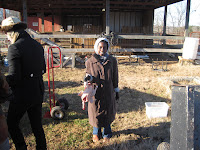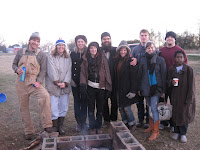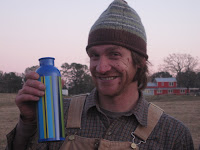I am happy to be here for primarily one reason. I received a scholarship. I typed up my farm plan, what we do here, what we want to do here, and they said, "We like this, and you may come," well, not literally, but figuratively, they gave me a free ticket. This is a good feeling.
I left home at 4 a.m.! State Road 53 is frightening at that hour of the day. The nocturnal animals were everywhere and the people were nowhere. Winding, winding, winding, I went into very dark and forested mountain places. This is the shortest route. I simply could not see the sense in going south on 75 to go north to Chattanooga. I saw it at 4 a.m. though. All I could think was, "My mom would kill me if she knew I was doing this." I made it with a little navigation from George back at home. I still have no GPS phone. I want a GPS phone.
I'm staying at the La Quinta Inn on the edge of town. Once again George has booked me into the 1970's model where all room access is interior. He knows that I am terribly claustrophobic. He promised he wouldn't do this again. There will be words.
It is chilly, damp, and gray, nestled in this valley town. I love the way that Chattanooga is all squeezed into the only flat area they could find. Lookout Mountain and her sisters encircle the town and appear to be looking over the whole manner of things. For someone like myself who has difficulty with missing turns and knowing how to get places this is a stroke of genius! I've been orienting myself by the mountain
 and the Tennessee River.
and the Tennessee River.  You can't go too far wrong or you will run into one or the other. It is a tiny bit claustrophobic too. What a handicap I have.
You can't go too far wrong or you will run into one or the other. It is a tiny bit claustrophobic too. What a handicap I have.This is the second day of the conference. I remember very little of yesterday. The 4 a.m. wake up caught up with me at about 6 p.m. and I lapsed into a twelve hour coma.
These things are always about the people for me. This is a smorgasbord of people watching. As I sit here in the Chattanooga Convention Center in what looks like an airport concourse and in an airport like chair, here is what I see. I'll use a clock face to orient you:
1. At twelve is a man in his 50's who appears to have been smoking at least some of what he is growing. His face is mouse-like and adorned with a bushy beard which has a single dread-lock approximately two inches in diameter that reaches (I'm not kidding) to his mid thigh. He is a permaculture guru and he has brought all of his own food in a cooler. His lunch is a tomato libation which he sips from a Mason jar - in this we are connected, I take almost all of my food to work in mason jars. His commitment to healthy food makes me feel very guilty for the Cadburry Caramello chocolate bar that I just consumed.
2. To my left at nine o'clock are two very common looking men, one in his 20's (who I think probably has a suspiciously good taste in furniture and fashion *wink*) and his companion in his 50's. They are discussing the importance of preserving native strains of corn seed. The older one comments that the man mentioned in #1 is wearing "last year's bird nest" on his face. He is also lamenting the last speaker who admitted to voting for George Bush - twice (gasp)!
3. At two o'clock looking to my right is a venerable, older black man in his 60's with ghostly white hair and beard. His voice sounds like Redd fox who played Fred Sanford in the t.v. show Sanford and Sons. He and his friend are talking about melon, corn yields, and last year's rain and market prices.
4. At 10 is a man who must have ridden here on his hog. Not the four footed one. His arms are sleeved with tattoos and he is sporting a long wiry braid down his back. His conversation with the conservative looking 50 somethings at his table is sedate, amiable, and unfortunately too quiet for me to hear.
5. There goes the mother with her three month old infant who "eats at Mom's" and has hiccups in every session that we attend together. She has been too busy for conversation. I admire her and nod knowingly in her direction. I remember trying to balance my desire to do things that mommies want to do and still care for baby.
6. Walking by is the young fella decked out in Abercrombie clothes, long curly chestnut hair, and a passel of brand new tools. He's apparently farming on a family trust or Daddy's American Express. Nube. He will soon find out that he doesn't need half of what he just bought, Goodwill is a far better source for farm clothes, and one must get dirty.
7. Standing between those of us in the airport chairs and those sitting at tables are a group of white southern farmers with plaid shirts, baseball caps, and Skoal in their rear pockets who apparently just got the email that folks don't want chemicals and genetically modified food anymore. They are excitedly and animatedly talking about their plans to convert a portion of their production to organic. This is so encouraging. They are here to learn the new old way.
8. The overweight women over 60 are scattered all around. Most grow garden vegetables or cut flowers. They give me hope that I might have at least another twenty years in the field (literally in the field.) They knit. In fact, almost all of the women here knit.
I don't knit. There must be something wrong with me.
*side note* ...the herb grower (#1) with the long dread is laughing an amazing laugh at something his companion has said. His eyes are scrunched up and he rapidly shakes his head sideways with amusement. That is adorable. He is such a happy guy. He makes me happy too. It is infectious.
I'm am in my final class and the young mother and her hiccuping baby have seated themselves beside me again. I must be giving off the old maternal musk. Baby tanks up and falls deeply asleep on his mother's lap. I am so envious - about the sleep. While she and I listen intently to the nuances of seed saving there is a long, loud, and gaseous emission from her general direction. I reflexively look her way and she whispers, "That wasn't me." I winked. At least it wasn't hiccups this time.
So what did I learn this weekend? I would have to say...drip irrigation. I had an excellent teacher in my drip irrigation class, Clynton Slade from Virginia. Mr. Slade was an extension agent for 28 years and is the consummate family farmer. He and his family produce fruits and vegetables for a local farmer's market and make a killing at it. He says he owes this to drip irrigation. I think that I get what he is saying because it is basically one large garden intravenous system. It has tubes, drip rates, stop-cocks, and it runs under the surface. You can even piggyback manure tea into it. I learned all of this in nursing school. Maybe I too can make a fortune. I can't wait to drip something.
So I have to share the best part of State Road 53. I'm through conferring and on my way home. I drove this route about ten years ago with a car load of sleeping Rinke spawn who were going to see grandparents in Kentucky. It was early morning then too. Driving through Tate, Georgia, because there is no town to drive into, in front of the elementary school, I saw the sweetest sight. A mother and her little son had their arms around the flagpole and they were holding hands, on their knees, praying before his school day started. It was Rockwellian. I've snapped a photo for you to see the flagpole and the school.
 I'm sure that little boy is probably a senior in high school now. I hope he still prays with his mom.
I'm sure that little boy is probably a senior in high school now. I hope he still prays with his mom.Tate is the self proclaimed granite capital of the world. I'm sure they are right. As you can see EVERYTHING is made of granite there. It appears that Taters ( I don't know if they call themselves taters but what else would they call themselves?) spend their time digging granite and marble. If you have had a proper earth science course you will know that marble is just granite plus a little extra time, heat, and pressure. There must be a million kitchen counter tops in them thar hills.
Surely you know of the Historic Tate House . It is very pink. Their government complex is pink granite too.
Here is one of the quarry operations.

Here's a little bonus for all you Facebook Farmville players. There really is a Farmville. They have a granite church.
 You guessed it.
You guessed it.  They are about 40 miles from the Taters.
They are about 40 miles from the Taters.





































